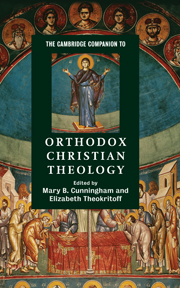Book contents
- Frontmatter
- Who are the Orthodox Christians? A historical introduction
- Part I Doctrine and Tradition
- 1 Scripture and tradition in the Church
- 2 Biblical interpretation in worship
- 3 God in Trinity
- 4 Creator and creation
- 5 The human person as image and likeness of God
- 6 Christ and salvation
- 7 Eschatology
- 8 The Church
- 9 Theology of the icon
- 10 The spiritual way
- Part II Contemporary Orthodox Theology: its Formation and Character
- Glossary
- Bibliography
- Index
- Series list
6 - Christ and salvation
from Part I - Doctrine and Tradition
Published online by Cambridge University Press: 28 March 2009
- Frontmatter
- Who are the Orthodox Christians? A historical introduction
- Part I Doctrine and Tradition
- 1 Scripture and tradition in the Church
- 2 Biblical interpretation in worship
- 3 God in Trinity
- 4 Creator and creation
- 5 The human person as image and likeness of God
- 6 Christ and salvation
- 7 Eschatology
- 8 The Church
- 9 Theology of the icon
- 10 The spiritual way
- Part II Contemporary Orthodox Theology: its Formation and Character
- Glossary
- Bibliography
- Index
- Series list
Summary
Christian Orthodoxy has never restricted its doctrine of salvation to a single plane. Rather, the answers to the questions of how we are saved, and even what it means to be saved, rest simultaneously in multiple dimensions or paradigms. Salvation is understood as theosis ('deification'), as communion, as illumination of understanding, as freedom from captivity; it is achieved through Christ's Incarnation, his divine-humanity, his teaching, his sacrifice on the Cross, the Church. Yet the registers within which we consider salvation are distinct only in human logic, where each must be discussed within its own boundaries: in truth they are thoroughly interdependent and distil to one reality.
What unites all Orthodox thinking about salvation is the total focus on Jesus Christ. Christ is 'the way, the truth, and the life' (Jn 14:6); we know no other name by which we may be saved (cf. Acts 4:12). He is our salvation. But it goes the other way as well: our thinking about Christ centres on salvation. All of the patristic, conciliar and liturgical formulations about the person of Christ - some of which are abstruse and technical, some of which were arrived at through martyrdom - are ultimately concerned with our salvation. The pursuit of an understanding of the person of Christ utterly consumes Christian thinking precisely because everything is at stake. It is a matter of eternal life and death.
This chapter will therefore maintain a double focus: on soteriology - reckoning on salvation - and on Christology - reckoning on Christ: two sides of the same coin.
- Type
- Chapter
- Information
- The Cambridge Companion to Orthodox Christian Theology , pp. 93 - 106Publisher: Cambridge University PressPrint publication year: 2008



